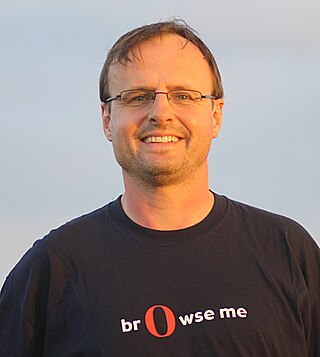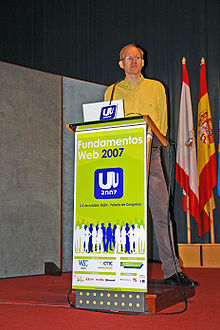
Hypertext Markup Language (HTML) is the standard markup language for documents designed to be displayed in a web browser. It defines the content and structure of web content. It is often assisted by technologies such as Cascading Style Sheets (CSS) and scripting languages such as JavaScript, a programming language.
Web design encompasses many different skills and disciplines in the production and maintenance of websites. The different areas of web design include web graphic design; user interface design ; authoring, including standardised code and proprietary software; user experience design ; and search engine optimization. Often many individuals will work in teams covering different aspects of the design process, although some designers will cover them all. The term "web design" is normally used to describe the design process relating to the front-end design of a website including writing markup. Web design partially overlaps web engineering in the broader scope of web development. Web designers are expected to have an awareness of usability and be up to date with web accessibility guidelines.
An HTML editor is a program used for editing HTML, the markup of a web page. Although the HTML markup in a web page can be controlled with any text editor, specialized HTML editors can offer convenience, added functionality, and organisation. For example, many HTML editors handle not only HTML, but also related technologies such as CSS, XML and JavaScript or ECMAScript. In some cases they also manage communication with remote web servers via FTP and WebDAV, and version control systems such as Subversion or Git. Many word processing, graphic design and page layout programs that are not dedicated to web design, such as Microsoft Word or Quark XPress, also have the ability to function as HTML editors.
An HTML element is a type of HTML document component, one of several types of HTML nodes. The first used version of HTML was written by Tim Berners-Lee in 1993 and there have since been many versions of HTML. The current de facto standard is governed by the industry group WHATWG and is known as the HTML Living Standard.

Eric A. Meyer is an American web design consultant and author. He is best known for his advocacy work on behalf of web standards, most notably CSS, a technique for managing how HTML is displayed. Meyer has written a number of books and articles on CSS and given many presentations promoting its use. Eric currently works for Igalia.
Web standards are the formal, non-proprietary standards and other technical specifications that define and describe aspects of the World Wide Web. In recent years, the term has been more frequently associated with the trend of endorsing a set of standardized best practices for building web sites, and a philosophy of web design and development that includes those methods.

Håkon Wium Lie is a Norwegian web pioneer, a standards activist, and the chairman of YesLogic, developers of Prince CSS-based PDF rendering software. He is best known for developing Cascading Style Sheets (CSS) while working with Tim Berners-Lee and Robert Cailliau at CERN in 1994. He was the chief technology officer of Opera Software from 1998 until the browser was sold to new owners in 2016.

Tantek Çelik is a Turkish-American computer scientist, currently the Web standards lead at Mozilla Corporation. Çelik was previously the chief technologist at Technorati. He worked on microformats and is one of the principal editors of several Cascading Style Sheets (CSS) specifications. He is author of HTML5 Now: A Step-by-Step Video Tutorial for Getting Started Today (ISBN 978-0-321-71991-1).
JavaScript Style Sheets (JSSS) was a stylesheet language technology proposed by Netscape Communications in 1996 to provide facilities for defining the presentation of webpages. It was an alternative to the Cascading Style Sheets (CSS) technology.
Tableless web design is a web design method that avoids the use of HTML tables for page layout control purposes. Instead of HTML tables, style sheet languages such as Cascading Style Sheets (CSS) are used to arrange elements and text on a web page.
In HTML, the standard markup language for documents designed to be displayed in a web browser, <div> and <span> tags are elements used to define parts of a document, so that they are identifiable when a unique classification is necessary. Where other HTML elements such as <p> (paragraph), <em> (emphasis), and so on, accurately represent the semantics of the content, the additional use of <span> and <div> tags leads to better accessibility for readers and easier maintainability for authors. Where no existing HTML element is applicable, <span> and <div> can valuably represent parts of a document so that HTML attributes such as class, id, lang, or dir can be applied.

CSS animations is a proposed module for Cascading Style Sheets that allows the animation of HTML document elements using CSS.

Cascading Style Sheets (CSS) is a style sheet language used for specifying the presentation and styling of a document written in a markup language such as HTML or XML. CSS is a cornerstone technology of the World Wide Web, alongside HTML and JavaScript.

The Arena browser was one of the first web browsers for Unix. Originally begun by Dave Raggett in 1993, development continued at CERN and the World Wide Web Consortium (W3C) and subsequently by Yggdrasil Computing. Arena was used in testing the implementations for HTML version 3.0, Cascading Style Sheets (CSS), Portable Network Graphics (PNG), and libwww. Arena was widely used and popular at the beginning of the World Wide Web.

In web development, the CSS box model refers to how HTML elements are modeled in browser engines and how the dimensions of those HTML elements are derived from CSS properties. It is a fundamental concept for the composition of HTML webpages. The guidelines of the box model are described by web standards World Wide Web Consortium (W3C) specifically the CSS Working Group. For much of the late-1990s and early 2000s there had been non-standard compliant implementations of the box model in mainstream browsers. With the advent of CSS2 in 1998, which introduced the box-sizing property, the problem had mostly been resolved.
The Web platform is a collection of technologies developed as open standards by the World Wide Web Consortium and other standardization bodies such as the Web Hypertext Application Technology Working Group, the Unicode Consortium, the Internet Engineering Task Force, and Ecma International. It is the umbrella term introduced by the World Wide Web Consortium, and in 2011 it was defined as "a platform for innovation, consolidation and cost efficiencies" by W3C CEO Jeff Jaffe. Being built on The evergreen Web has allowed for the addition of new capabilities while addressing security and privacy risks. Additionally, developers are enabled to build interoperable content on a cohesive platform.
Argo was part of a project to make the Internet accessible to scholars in the Humanities at the University of Groningen. The Argo web browser was created in August 1994 by Bert Bos.
The CSS Working Group is a working group created by the World Wide Web Consortium (W3C) in 1997, to tackle issues that had not been addressed with CSS level 1. As of December 2022, the CSSWG had 147 members.
Front-end web development is the development of the graphical user interface of a website through the use of HTML, CSS, and JavaScript so users can view and interact with that website.
Prince is a computer program that converts XML and HTML documents into PDF files by applying Cascading Style Sheets (CSS). Prince is a commercial product, which is free to download and use for non-commercial purposes.








